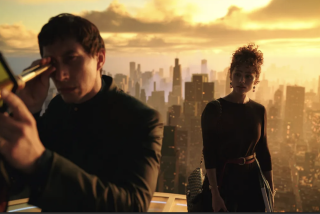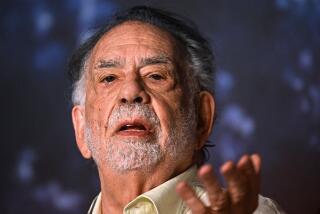An ambitious ‘Youth’
“Youth Without Youth,” Francis Ford Coppola’s first film in 10 years, is based on a novella by Romanian comparative religion scholar Mircea Eliade. Ambitious in scope and byzantine in logic, the movie tackles time, consciousness, reality, the mystery of human potential, the origins of language, the likelihood of lightning striking twice within one couple, even if one of them is the reincarnation of her lover’s former lover -- all the big enigmas.
The movie begins in 1938, in Romania, where Dominic Mattei (Tim Roth), an 80-year-old scholar and a linguist, struggles to complete his book on the origin of human language and consciousness, for which he gave up the great love of his life decades earlier. Fearing that his life will have amounted to nothing if he doesn’t finish it, a frustrated and desperate Dominic leaves his town and travels to Bucharest with the intention of ending his life. Before he can go through with it, however, he is struck by lightning and charred beyond recognition.
Miraculously, he not only recovers, but finds that his youth has been restored while his mental abilities have increased exponentially. He has only to wave a book under his nose, for instance, to absorb its contents. He’s able to recall every experience he’s ever had. And he’s able to bend metal with his mind, which comes in very handy when being chased by Nazis with guns. He has also acquired a double (a version of himself who exists on a slightly different plane and with whom he has fraught conversations about moral dilemmas); a good friend, Dr. Stanciulescu (Bruno Ganz), who proclaims him “the most important medical specimen in the world”; a persecuting Nazi doctor; and a secret-agent lover with whom he spends his nights and doesn’t remember the next morning.
As time goes by, Dominic realizes that he is more than a super-intellectual, he is “a mutant of the future . . . with access to knowledge unavailable to mankind.” The war ends and the Cold War begins. He stops taking notes in English and starts taking them in an invented language that will be decipherable only by computer in 2010. Decades pass and he works feverishly on his message to future generations. (It’s a ringing endorsement for deadlines if ever there was one.) He starts to outlive his foes and narratives, not to mention audience interest. Sometime in the mid-’60s, he lost me too. Once the lost love, recaptured youth and Nazi persecution threads expire due to the man’s sheer longevity, it’s hard to invest in the new stories. It’s not that intriguing new ones don’t develop, it’s that, as in life, the narratives of youth have a greater impact and resonate longer.
For a movie with a modest budget, however, “Youth Without Youth” is gorgeously shot by Mihai Malaimare Jr. and designed by Calin Papura but impressively far-flung, traveling from Romania to Switzerland, Italy to India to the Mediterranean and across three decades seemingly effortlessly. In Italy in the 1960s, Dominic meets Veronica (Alexandra Maria Lara), identical to his ex-fiancee Laura, who also survived a lightning bolt to find she had been transported across time and space, to where she is now one of the first Buddhists in India. Later they travel together to Macedonia.
Roth does an almost too credible job of playing a man living outside of time and his own identity, but there’s something about the role that requires him to shrink back from the screen. Mild-mannered, scholarly, on the lam -- he hides in plain sight. Dominic might be a miracle of cellular renewal, but I found it hard to keep generating interest in each new thread and esoteric theory, especially as it became increasingly clear that the ends wouldn’t be tied up in any satisfying way. Ultimately, “Youth Without Youth” is more intriguing than it is satisfying. It hooks you, then lets you flounder.
--
“Youth Without Youth.” MPAA rating: R for some sexuality, nudity and a brief disturbing image. Running time: 2 hours, 6 minutes. In limited release.
More to Read
Only good movies
Get the Indie Focus newsletter, Mark Olsen's weekly guide to the world of cinema.
You may occasionally receive promotional content from the Los Angeles Times.







